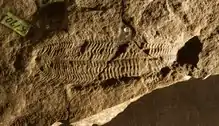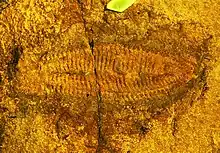Protonympha
Protonympha is a form genus for problematic fossils of Devonian age in New York. It has been of special interest because of its morphological similarity with the iconic Ediacaran fossil Spriggina, and may have been a late surviving vendobiont.[1]
| Protonympha Temporal range: | |
|---|---|
 | |
| Holotype specimen of Protonympha salicifolia from the Late Devonian (Frasnian) Gardeau Sandstone near Naples, New York | |
 | |
| Holotype specimen of Protonympha transversa from the Middle Devonian (Givetian) Moscow Formation near Summit, New York | |
| Scientific classification | |
| Kingdom: | Animalia (?) |
| Genus: | †Protonympha Clarke 1903 |
| Species | |
| |
Description
Protonympha is a flat, quilted fossil, which has previously been compared with the arm of a starfish or an annelid worm, but lacks a segmented carapace or stereom. Its preservation in sandstone is similar to Ediacaran type preservations.[2] A less-accepted hypothesis claims the organisms were terrestrial fossils like lichen, with hypothetically interpreted rhizoid-like extensions as possible evidence it may have lived on land or in shallow pools.[1]
References
- Retallack, G.J. (2018). "Reassessment of the Devonian Problematicum Protonympha as another post-Ediacaran vendobiont". Lethaia. 50 (3): 406–423. doi:10.1111/let.12253.
- J. J. Sepkoski. 2002. A compendium of fossil marine animal genera. Bulletins of American Paleontology 363:1-560
This article is issued from Wikipedia. The text is licensed under Creative Commons - Attribution - Sharealike. Additional terms may apply for the media files.